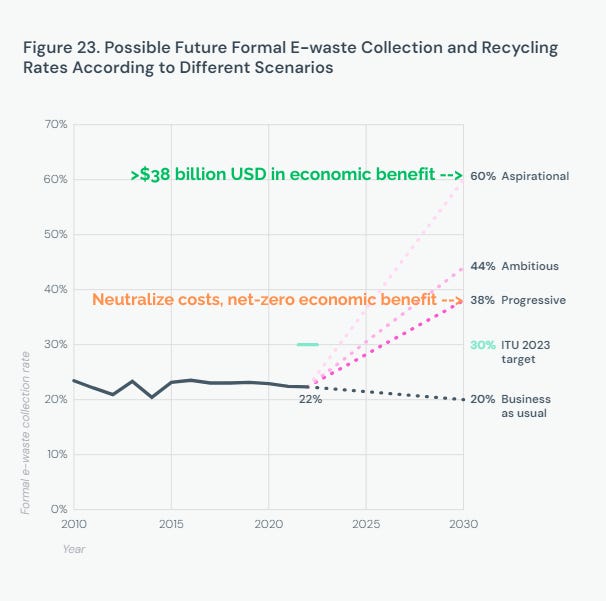E-Waste: From Trash to Treasure
Assessing the global e-waste problem and the necessary transition to a circular model for electronics through sustainable design, material recovery and recycling innovations.
In our fast-paced digital age, e-waste is one of the fastest-growing waste streams, projected to reach a staggering 82 million metric tons per year by 2030 - equivalent to about 205,000 fully loaded jumbo jets, 13.7 million elephants, or 225 Empire State Buildings.
We’ve become deeply attached to our smartphones, computers, and countless other accessories that shape our identities and enable our modern lives. Yet, when we’re done with our indispensable gadgets, we often move on to the next with little regard. A 2015 UNEP report estimated that 60-90% of the world’s electronic waste, worth nearly 19 billion USD, is illegally traded, incinerated, or dumped each year, affecting local communities through the toxic chemicals that get released from poor disposal, contaminating the air, soil, dust, and water to ultimately harm our health and well-being.
From Earth to Body: Toxic Consequences
Massive waste from industrialization and consumer society, composed of hazardous chemicals, precious metals, and other materials improperly dumped, has unfortunately already damaged generations of populations. E-waste adds further to that. Here are three prominent examples:
Lead Poisoning: Historically valued for its durability, malleability, and corrosion resistance, lead became an escalating problem in the mid-20th century. Increased use in consumer products like paint and gasoline led to a surge in lead exposure, affecting a generation of Americans with diminished IQs, altered personality traits, and increased crime rates.
PFAS (Per- and Polyfluoroalkyl Substances): Used in various consumer products like non-stick cookware and food packaging, these chemicals are leaching into our drinking water and soil when disposed. Current scientific studies indicate adverse effects for pregnant women, developmental effects or delays in children, and increased cancer risks.
Microplastics: These tiny particles from plastics are ingested unknowingly from what we eat, drink and breathe. They are embedded in our all parts of our bodies, including our heart and brain. While the long-term effects are largely unknown, early scientific insights suggest increased vulnerability to heart disease, cancer and other illnesses.
Arcadia Earth - An E-Waste Exhibit
Museums have always been sources of knowledge and inspiration, and they’re evolving to address contemporary issues like climate change. During a recent visit to Arcadia Earth in Toronto, I was inspired by one striking installation called the 'E-Waste Generator', featuring creatively repurposed e-waste and a throne made entirely of discarded keyboards.
Embracing The Electronics Circular Economy
Inspired by the visit and the spirit of taking action, I undertook extensive spring cleaning, selling and donating old electronics accumulated over years.
However, tackling e-waste requires systematic changes. In 2019, the United Nations set a global framework for a circular economy approach to e-waste management called the 'New Circular Vision for Electronics'. It calls for transforming our current systems of ‘take, make and waste’ to a circular economy that benefits all:
Reduce (Take)
Dematerialization: The easiest solution for all e-waste issues is still not to generate any e-waste in the first place. Companies are increasingly prioritizing recyclability and circularity at the manufacturing stage, using minimal resources and ethically sourced materials and considering how metals and minerals can be more easily recovered from devices in a financially viable way. The trend of reducing physical hardware and material use is underway by shifting to more virtual, service-based models like cloud computing and streaming media.
Sustainable Design at CES 2024: At the Consumer Electronics Show, big tech companies showcased commitments to sustainable product designs, with particular focus on ‘closed loop recycled plastics’. For example, LG aims to use recycled plastics across 19 product lines with a 95% recycling rate by 2030.
Re-Use (Make)
Planned Obsolescence: Too many products are replaced once a newer, more sophisticated version comes out, or disposed of when they show signs of malfunction. It’s a strategy used by companies to increase sales by encouraging this wasteful behaviour among consumers, subtly slowing down devices or causing them to wear out prematurely to artificially reduce their lifespan.
Right to Repair: This legal right for device and equipment owners to freely modify and repair products is gaining great momentum in 2024. Google has proposed policies in a new white paper to empower people to prolong the life of their Pixel smartphone devices. More legislation is being passed in many US states, and the EU’s updated legislation, passed in April, advances requirements such as modular design, user labels for repairability and durability, more easily replaceable batteries, and upcoming regulations for repairing laptops.
Recycle (Waste)
Consumer Technology Circularity Initiative (CTCI): Announced on the first day of CES 2024, this voluntary industry initiative to reduce waste, enhance recycling, and lower climate impact. Founding members like Lenovo, LG Electronics, Panasonic, Samsung, and Sony Electronics Inc. are committed to developing innovative solutions that help the circular economy become a reality.
Urban Mining: This promising and lucrative practice reduces our carbon footprint by extracting valuable metals and minerals from billions of smartphones and other consumer devices that would otherwise end up in landfill or be incinerated. Recovering and circulating materials into new products not only has significant economic potential, but also reduces the strain on local ecosystems and pollution from mining at the source, especially as the world’s consumption of raw materials is set to double by 2060.
The Informal Sector and E-Waste Challenges
While progress is being made, standardizing recycling processes remains inherently difficult due to the sheer scale and variety of components in different electronics. Increasing consumer options and the growth of lithium-ion EV batteries, IoT devices, cryptocurrency, and AI data centre hardware further compound this challenge.
With much of the world's e-waste going unrecycled and unaccounted for, a shocking amount ends up being illegally traded or dumped in lower-income nations. This has given rise to informal "backyard" sectors comprised of resourceful entrepreneurs and low-wage workers who collect, disassemble, and try to extract value from e-waste through crude techniques like open-air burning and acid baths.
It’s a common source of income for marginalized communities and often supports formal waste agencies like municipalities; however, there are virtually no safety measures, environmental safeguards, or oversight. The ILO and WHO estimate millions, including many women and children, work in these unregulated conditions, exposing themselves and their surroundings to hazardous toxins from improper handling and processing of e-waste components.
Innovative E-Waste Solutions
Recognizing the economic benefits delivered by a circular model for electronics, there’s ample opportunity to create more sustainable, green jobs for repairing used electronics, along with collecting and pre-treating e-waste. Formalizing informal sectors around the world will increase the rates of valuable recovered materials and greatly improve working conditions.
AI-powered robotics can also play a pivotal role; they give us a glimpse into the future and can significantly assist with e-waste management by automating sorting, disassembly, and recycling processes. This minimizes human exposure to harmful substances and increases the efficiency of extracting valuable metals. For example, Apple's Daisy robot disassembles iPhones to recover valuable components. These technologies can enhance recycling efficiency, reduce labour costs, and ensure safe handling of toxic materials at scale.

To bridge the digital divide and empower communities, using and sharing existing essential resources are both crucial and economically promising. As well, joint global agencies and organizations have been raising the alarm bells for awhile now. Prioritizing legislation will help with uneven global progress on e-waste management - the EU is at the forefront of e-waste management leading with a 42.5% collection and recycling rate, but regions like the Middle East, India, and Brazil have recycling rates close to 0%. We have a significant task ahead to steer us in a positive trajectory; it starts with better appreciating the circular value of our electronics and thoughtfully managing its waste.




